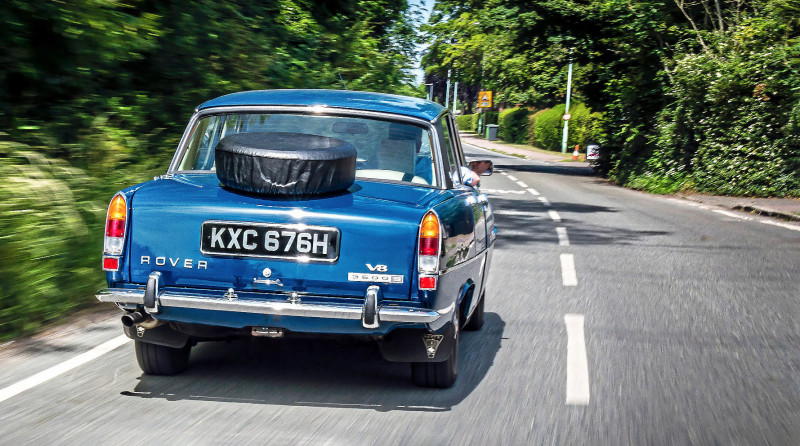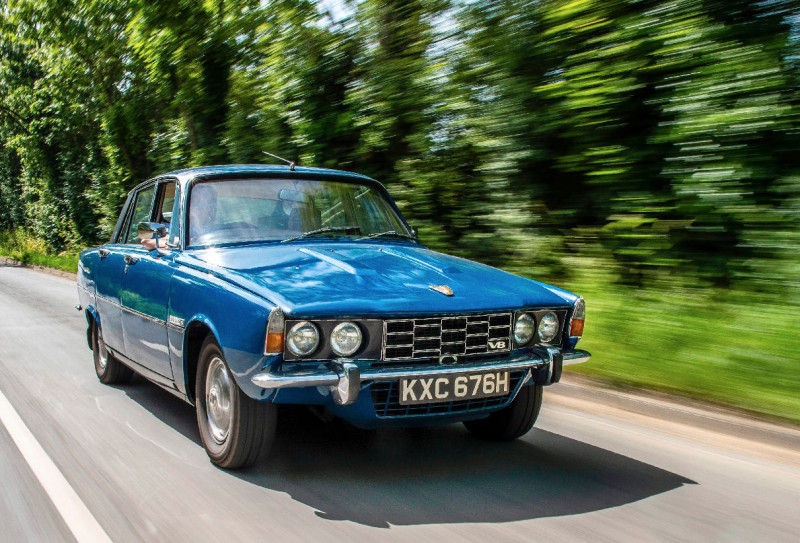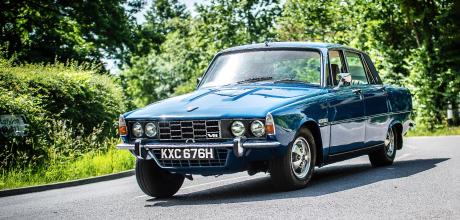1970 Rover P6B 3500S prototype
As ‘1970 Manual Prototype Number One’, this car spent five years and hundreds of thousands of miles being developed by its maker. Today we drive it and ask: is this the zenith of the Rover P5B 3500S?
Words IVAN OSTROFF
Photography IAN SKELTON
This prototype Rover 3500S survived its test rigours. Time for another
The Solihull secret
The Solihull Secret We drive the prototype that sired the manual Rover P6B 3500S
The bootlid-mounted spare wheel. A curious factoryfit conversion that became something of a cult P6 statement. In this case it serves as something of a red herring, because while KXC 676H might otherwise outwardly look little different from any other 1970 P6B MkII, it’s one of the most historically important. This car served a prototypical role for five years, acting as a testbed for developments that would finally allow the model to reach its full potential – specifically the manual-gearbox, V8-engine 3500S.

The first clue to this provenance comes once you’ve settled aboard and acquainted yourself with the P6’s characterful interior – the manual gear lever boasts access to the five forward ratios of an LT77 transmission, rather than the four-speed unit used in the production manual P6B launched in 1971. During that half-decade of service this car was also used as an engine testbed; powerplant swaps were frequent enough for engine designer Albert Cartwright to find devising a quick-release removable front panel worthwhile.

I fire the engine to be met by the purring throb of the same experimental V8 with which the car left Rover’s ownership in 1975. Without a torque converter to suck up power, the manual 3500S is more responsive than an automatic 3500. Trickling along through town traffic in second or third, the exhaust burbles merrily; it will even pull away in fifth gear at 1000rpm without too much complaint. But stamp on that throttle in an appropriately low gear and as the revs increase, the tone hardens. The V8 seems to come on cam as the revs pass through 4300, at which point the exhaust note becomes ever more vocal – and thanks to that five-speed ’box I can conduct the music to my preference. Pushing the engine past 4500 is a delight.

Robert Pinner, who owned this car from 1997-2009, got to know the engine intimately a few years into his ownership. ‘It was smoking, so I set about rebuilding it. It was only then that I noticed that the serial number on the cylinder block denoted it was experimental. The crankshaft and pistons were certainly standard items, the cylinder heads were mildly ported and from RPI – so probably a post-factory addition. They were also fitted with SD1 valves, which are larger. The exhaust manifolds were recognisable as what was used on the SD1, but the inlet manifold was also an experimental item and somewhat different from the standard P6 item, although I could not see how or why. The camshaft was tweaked and of Piper origin, the carburettors were the SU HIFs and I noticed that instead of a rope crankshaft oil seal, it had a neoprene one. Once rebuilt it was probably developing approximately 30bhp more than a regular Rover V8.’

The engine might not run as silky-smooth as a standard unit, but with the modified camshaft, that’s to be expected. It’s certainly not rough and ticks over quite smoothly, just a tad more burbly. That said, if you change up to third too early exiting a quick second-gear corner, the V8 can drop off the cam, resulting in a temporary lack of grunt while the torque climbs back and pulls you out of trouble. Be in the right gear at the right time though, and this engine and five-speed gearbox are perfect suitors. Changes up and down through the LT77 reward with a satisfyingly smooth and snicky action. You certainly don’t need to double declutch, but I tend to out of habit. The pedals are slightly out of alignment for heel and toe work unfortunately, the throttle pedal just a little too low.
Storm into a corner too fast and the all-round disc brakes haul off speed impressively. They’re progressive and more than adequate by the standards of the era. Charles Spencer 'Spen' King’s ‘round-the corner’ suspension design was equally advanced for its time – it was conceived to leave room for an ultimately stillborn gas turbine engine – and used the stiffest part of the structure to soak up load. The front end is controlled by struts and a bell crank, in conjunction with horizontal coils springs and telescopic dampers. At the rear there are coilover dampers and a de Dion tube axle, designed to rotate and telescope. The layout provides an amazingly comfortable ride. Although cornering roll is more pronounced when cornering than I had anticipated, the rear suspension works well; the tail sticks and the car doesn’t want to break away, so the 3500S tends towards understeer. When provoked with the throttle however, it will certainly allow a controlled slide.
Owner Jay Cable has fitted heavy duty springs to KXC because he often loads the car up for trips with the whole family plus luggage. This has made the ride firmer than standard but the car does feel stable on the road. Jay explains, ‘These cars can sag over time because of the weight at the rear, but KXC always sits right and drives perfectly.’ While the ride is comfortable and compliant, the car manages to be responsive and handle predictably. The experience is helped by worm and roller variable-ratio steering which is light and tactile yet provides plenty of feedback and feel so that you know exactly what’s going on up front, all without excessive road shocks being conveyed through the column.
The original concept behind the project was to provide Rover America with a manual version of the NADA (North American Dollar Area) 3500S that could be marketed as a sports saloon like the Federal Rover 2000TC had been before it; the automatic NADA 3500 had not enjoyed the anticipated success Stateside. When the P6B was launched in April 1968 it was only available as an automatic, although there were attempts to get a manual version into production using a ZF gearbox. When this gearbox was found to rattle at idle and the only way the Rover engineers could quieten the unit was to use specialist oils, that proposal was passed over as being unviable.
When this P6B MkII, chassis number 703-500001-M – meaning 1970 3500 manual number 1 – travelled down the production line December 1970, it was in NADA specification destined for the US market. That meant chunky rubber-faced bumper overriders, side impact bars within the doors, electric windows, an Icelert and leather transmission tunnel finisher. However, it was lifted straight from the production line by the Experimental Engineering Department, converted to right-hand drive and fitted with its first V8 engine, number 430-00008A, meaning the eighth NADA V8. Following inspection, this Corsica Blue-over-black-leather P6B was registered KXC 676H at Solihull Vehicle Registration Office on the 1 January 1970, then officially handed over to Experimental.
KXC 676H was a hard-driven workhorse. In the summer of 1970, Rover project engineer Jim Shaw took it on a long-distance test trip to southern Spain, where it was photographed over the Sierra Nevada mountains. In late 1973 or early 1974 KXC was fitted with a pre-production version of the LT77 five-speed gearbox. It had similar ratios to the earlier four-speed unit but with the sensible addition of a fifth ratio, and it later saw service in the P6’s successor, the SD1. Rover kept the car on its test fleet for five years, by which point it covered several hundred thousand miles. In July 1975, the car was finally sold off to Rover engineer Doug De Launte.He used the 3500S extensively until eventually it was laid up and left to become near-derelict.
When De Launte passed away, his family sold KXC for spares to another Rover engineer, ‘Ginger’ Bill Mountford, who fitted the NADA bits to his own car. Mountford sold the remains to Albert Cartwright, the instigator of the car’s quick-release front panel. He had good memories of working on KXC so set about restoring it – but he’d always felt that bright orange was the only colour the model looked right in, so he repainted KXC. After five years of use as his daily driver and tow car for his powerboat, Cartwright laid the car up when he was given a new car from Austin Rover’s employee car scheme.
In 1997 Cartwright decided to knock his garage down and clear out both his parts cache and KXC 676H, giving Rob Pinner first refusal on the entirety. Pinner remembers, ‘The Rover needed work but I managed to get it back on the road fairly quickly, although I did have to do a load of welding to the floor and the sills for the MoT test. Albert swore by Waxoyl and said it always stopped the rot, but he was wrong!
‘I covered about 30,000 miles a year in the car, including some enjoyable historic rallying, although we generally came last. On one occasion somewhere near Milton Keynes, we took off going over a humpback bridge and rammed the exhaust into the ground when we landed. The two flat patches on the downpipes will probably still be there.’
After three or four years Rob decided to take the car off the road and repaint it in the original Corsica Blue. He used to take it to shows and continued to use it as a daily car until 2003 when he too took it off the road. Then in 2009, divorce prompted its sale to James Esdaile of Wandsworth, who took the car to specialist MH Annable & Son in Derby for bodywork restoration. When the KXC emerged in its fresh paint, with the exception of the missing NADA bumpers, it looked much as did when photographed in 1970 on the Sierra Nevada trip.
In 2019 the car changed hands yet again and this time it was bought by current custodian Jay Cable, ‘It would be great to put the car back to its original specification but I would have to get hold of the appropriate NADA spec bumpers and doors. That would probably entail finding another NADA car, preferably with a good usable black interior, and then swapping things around. For now I’m enjoying the privilege of owning and driving it. One of the NADA spec items it does retain is the Icelert and the control warning light on the dash. Originally, there would also have been a box with the appropriate sensors on the front to tell the unit when road conditions were icy, so that's another job for the future.
‘Compared to the standard production four-speed manual gearbox, this LT77 has that very useful extra ratio. I always found the four-speed far more clunky, and to my mind, the rev range on that is basically wrong. In second and third it’s too long and then in forth, it's too short. The LT77 five-speed does work well on this car and is very pleasant to use. The car feels so much more responsive and you have that extra feeling of control because the right ratio is available all the time. At 70mph in fifth, the engine is spinning at about 2000rpm instead of something over 3000 in fourth with the four-speed. So the car is quieter, less buzzy. On the road, I have first to fourth to deliver buckets of tractability before popping it into fifth and relaxing. I use fifth almost like an overdrive ratio so the engine remains quiet and unstressed at higher speeds.
‘About a year ago, I came across another engine that Rover had used in this car and it is particularly interesting because it’s fitted with a fuel injection system. I bought it, and have it tucked away at home in my garage. In due course I rather fancy fitting it, just to see what the difference in the performance will be like. On the other hand, I might miss the extra power developed by this carburettor-fed experimental unit.’
It would be difficult to justify changing anything about KXC 676H in its current form. The boot-mounted spare wheel and missing NADA bumpers are matters of personal preference, but the rorty experimental engine and LT77 five-speeder make a formidable pair – and arguably make even more sense for classic use. Most enthusiasts of today would happily trade off some refinement for an engine that feels more alive, while the gearbox makes cruising to events and mixing it with modern traffic a more enjoyable experience. The car handles everything thrown at it well, is so much fun to drive and is exceptionally quick for its age. Cost reasons led Rover to equip the production manual 3500S with a strengthened version of the four-cylinder Rover 2000’s gearbox with an integral oil pump, a layout it carried to the grave. But I can’t help think that this is the ultimate form the manual 3500S might have taken had budgets been a little looser, and the car’s stay of execution a little longer.
Thanks to: Nick Dunning at the Rover P6 Club (p6club.com)
TECHNICAL DATA 1970 Rover P6B 3500S prototype
- Engine 3528cc V8, ohv, two SU HIF carburettors
- Max Power 190bhp @ 5400rpm
- Max Torque 240lb ft @ 2950rpm
- Transmission LT77 five-speed manual, rear-wheel drive
- Steering Worm and roller, power assisted
- Suspension Independent all round. Front: coil springs over telescopic dampers. Rear: coil springs over telescopic dampers, de Dion tube
- Brakes Servo-assisted discs all round
- Weight 1295kg (2854lb)
- Performance Top speed: 135mph
- 0-60mph: 9.0sec
- Price new £2482.15s
- Classic Cars Price Guide £3000-£12,500 (standard P6B 3500S)
The willingness of three Rover engineers to buy this P6 privately speaks of the high regard it was held in
OWNING A P6B PROTOTYPE
‘I bought it four years ago,’ says current owner Jay Cable. ‘I had owned a 3500S previously and always regretted parting with it. ‘There’s a part of me that says in due course why don’t we put it back to how it was originally because it was quite nice but conversely, it is where it is today. I like it, and it’s usable; it looks good but still has its heritage. It’s good to have two of the original engines that were fitted to the car when it was in factory use.
‘People are always coming up to me and relating tales of their dad or grandpa having had one, I get lots of lorry drivers waving at me and calling out that it’s a nice car. Everyone likes it, other drivers always stop to let me out of side roads into the traffic.
‘Do I use it enough? Probably not, although we take it on holiday occasionally and to Goodwood every year; more often it’s down to the pub. About three years ago, the alternator failed on the M4 so I put a battery pack on it and drove home. Otherwise it has been pretty reliable and problem free. About six months ago, I had to change the clutch, which was bit of a concern because I didn’t know what sort it had. It ended up being an SD1 item, so quite straightforward.
‘I love the V8 and the sensation of its reserve of power. I like the way the car handles, it’s an enjoyable machine that you have to actually drive. It’s fun to throw down B road, yet it’s just as at ease cruising along motorways.’
Rover kept the car for five years; it covered several hundred thousand miles’
Icelert system part of NADA specification list Experimental engine used to test SD1 parts Chassis plate signifies this car’s importance
This example still rolls through corners, despite it having heavy-duty springs.Familiar driving experience, albeit more involving.
Situation-normal fixtures despite prototype status.
LT77 eventually served in the P6’s successor You can almost feel the stalk’s damped action...



P6B prototype recalled
Your article on the Rover P6B prototype (Solihull Secret) reminded me of spring 1967, when I was working in the London office of Pirelli which bought a 3500S prototype car from Rover for tyre testing. When I later joined the technical department, I became aware of its reputation for speed and ability to rip the front bearing and oil seal out of its ZF five-speed manual gearbox at frequent intervals, about 3000 miles as I recall. The engine was basically Buick, I think, but maybe souped up.
Around 1967 a member of the public wrote to Motor or Autocar and said, ‘I was driving up the M1 in my 2000TC and was overtaken by another 2000TC. It was lefthand drive, green, had Solihull plates and was driven with spirit. I took my car to over 100mph and then the other driver waved, changed up a gear, and shot off over the horizon. There is clearly a new Rover in development’. I understand Rover was furious. I was granted a test drive in 1970. The test drivers advised, ‘If you’re in a hurry, try first, third and fifth gears; otherwise second and fifth is fine. There is so much torque you wouldn't believe it!’ I drove off from Burton on Trent onto the A38 slip road and booted it. Wow, what an effect. There was barely time for gear changes.
It was one of about five of equivalent specification. They were left-hand drive with glassfibre radiator cowls. One other went to a competitor tyre company. I turned down the opportunity to buy the car because it was dubious regarding spares. I think it went to the Measham car auction and made about £200. When the production P6B came up for sale I expressed an interest but the senior executive to whom I reported was not eligible for a V8, so he prevented one of his managers (me) from buying it.